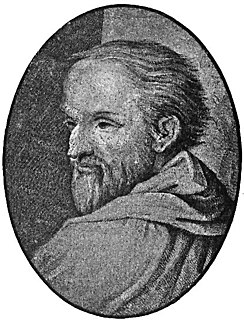
Antonio Allegri da Correggio, usually known as just Correggio, was the foremost painter of the Parma school of the High Italian Renaissance, who was responsible for some of the most vigorous and sensuous works of the sixteenth century. In his use of dynamic composition, illusionistic perspective and dramatic foreshortening, Correggio prefigured the Baroque art of the seventeenth century and the Rococo art of the eighteenth century. He is considered a master of chiaroscuro.

Annibale Carracci was an Italian painter and instructor, active in Bologna and later in Rome. Along with his brother and cousin, Annibale was one of the progenitors, if not founders of a leading strand of the Baroque style, borrowing from styles from both north and south of their native city, and aspiring for a return to classical monumentality, but adding a more vital dynamism. Painters working under Annibale at the gallery of the Palazzo Farnese would be highly influential in Roman painting for decades.

Girolamo Francesco Maria Mazzola, also known as Francesco Mazzola or, more commonly, as Parmigianino, was an Italian Mannerist painter and printmaker active in Florence, Rome, Bologna, and his native city of Parma. His work is characterized by a "refined sensuality" and often elongation of forms and includes Vision of Saint Jerome (1527) and the iconic if somewhat anomalous Madonna with the Long Neck (1534), and he remains the best known artist of the first generation whose whole careers fall into the Mannerist period.

Giuseppe Maria Crespi, nicknamed Lo Spagnuolo, was an Italian late Baroque painter of the Bolognese School. His eclectic output includes religious paintings and portraits, but he is now most famous for his genre paintings.

Justus Sustermans, Joost Sustermans or Suttermans, his given name Italianised to Giusto, was a Flemish painter and draughtsman who is mainly known for his portraits. He also painted history and genre paintings, still lifes and animals.

Museo di Capodimonte is an art museum located in the Palace of Capodimonte, a grand Bourbon palazzo in Naples, Italy. The museum is the prime repository of Neapolitan painting and decorative art, with several important works from other Italian schools of painting, and some important ancient Roman sculptures. It is one of the largest museums in Italy. The museum was inaugurated in 1957.
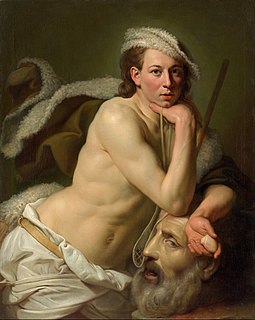
Johan Joseph Zoffany, RA was a German neoclassical painter who was active mainly in England, Italy and India. His works appear in many prominent British collections, including the National Gallery, the Tate Gallery and the Royal Collection, as well as institutions in continental Europe, India, the United States and Australia. His name is sometimes spelled Zoffani or Zauffelij.
Events from the year 1760 in art.

The Tribuna of the Uffizi (1772–1778) by Johan Zoffany is a painting of the north-east section of the Tribuna room in the Uffizi in Florence, Italy. The painting is part of the United Kingdom's Royal Collection.
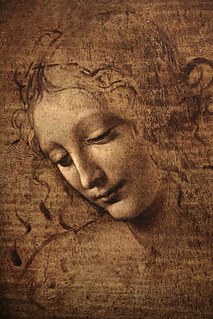
La Scapigliata is an unfinished painting generally attributed to the Italian High Renaissance artist Leonardo da Vinci, and dated c. 1506–1508. Painted in oil, umber, and white lead pigments on a small poplar wood panel, its attribution remains controversial, with several experts attributing the work to a pupil of Leonardo. The painting has been admired for its captivating beauty, mysterious demeanor, and mastery of sfumato.
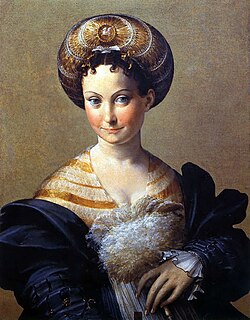
Turkish Slave is a painting by the Italian Mannerist artist Parmigianino, executed around 1533. It is housed in the Galleria nazionale di Parma, northern Italy.

Madonna and Child is a 1621–1627 painting by Anthony van Dyck, now in the Galleria nazionale di Parma.
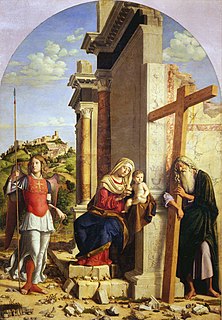
The Madonna and Child with Saints Michael the Archangel and Andrea is a Cima da Conegliano painting oil on panel dating from c. 1496–1498, and preserved at the Galleria nazionale di Parma.

Victoria Marjorie Harriet Paget, Marchioness of Anglesey was a British writer on art, an illustrator, and a member of the peerage.

Healing of the Man Born Blind is a c.1573 painting by El Greco, showing the healing the man blind from birth. It is now in the Galleria nazionale di Parma. It is signed at the bottom right-hand corner. It shows the artist returning to a theme he had first painted five years earlier, in a work now in Dresden.

Pope Paul III with a Nephew is an unfinished 1534 oil on slate portrait by Sebastiano del Piombo, now in the Galleria nazionale di Parma. The nephew's identity is unclear but the painting's presumed date suggests it may be Ottavio Farnese, whom Pope Paul III made Duke of Parma and Piacenza soon after the work's date

Portrait of a Man in a Red Beret or Self-Portrait in a Red Beret is an oil on paper painting attributed to Parmigianino or Michelangelo Anselmi, executed c. 1540, now in the collection of the National Gallery of Parma.

Self-Portrait is a 1593 oil on canvas painting by Annibale Carracci, now in the Galleria Nazionale di Parma. It is dated 17 April 1593 on the top left of the canvas.

Pietà with Saints Clare, Francis and Mary Magdalene is a 1585 oil on canvas painting by Annibale Carracci, now in the Galleria nazionale di Parma.

Maria Callani was an Italian portrait painter, active in the 18th century in Milan and Parma, Italy.


















